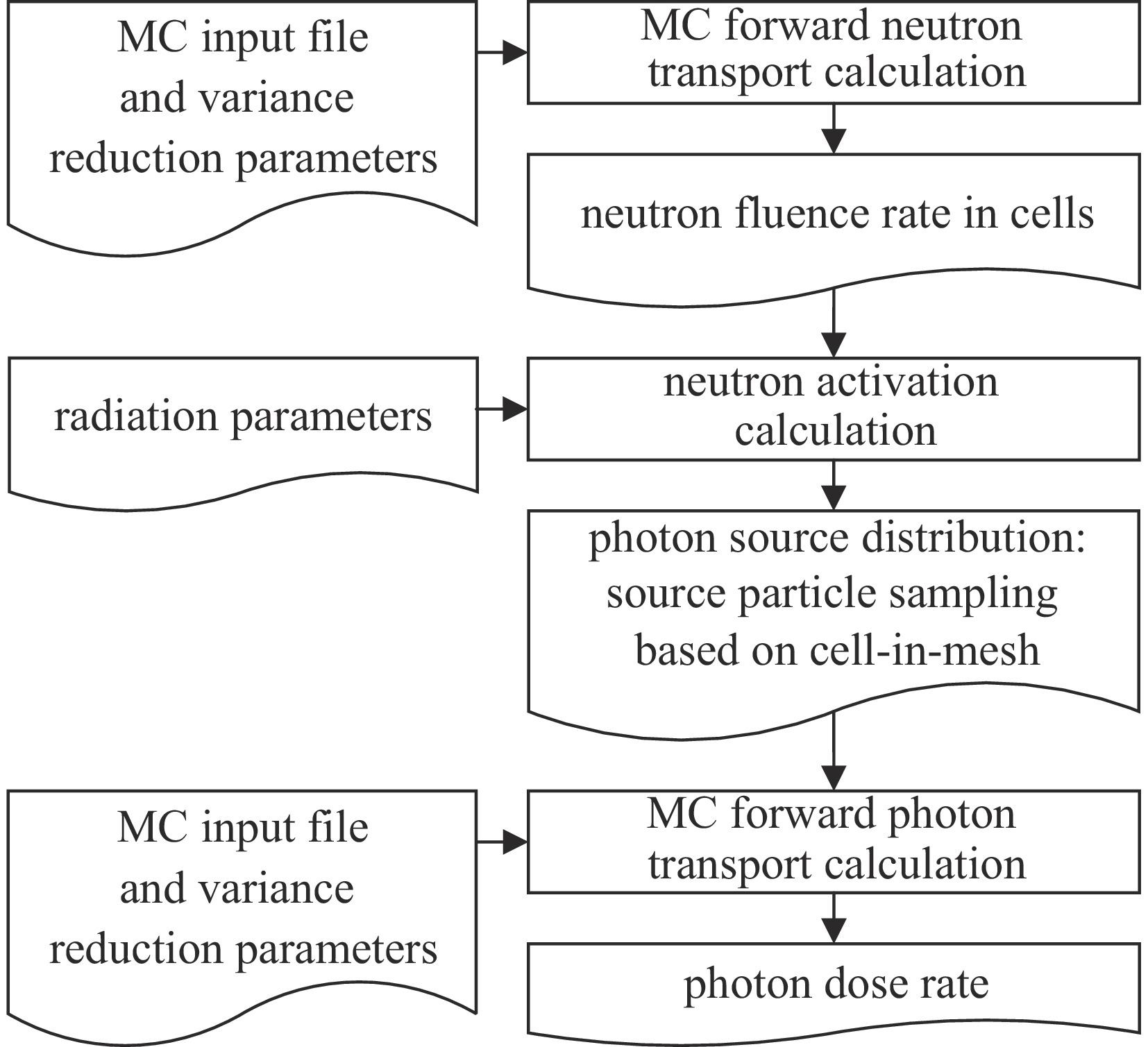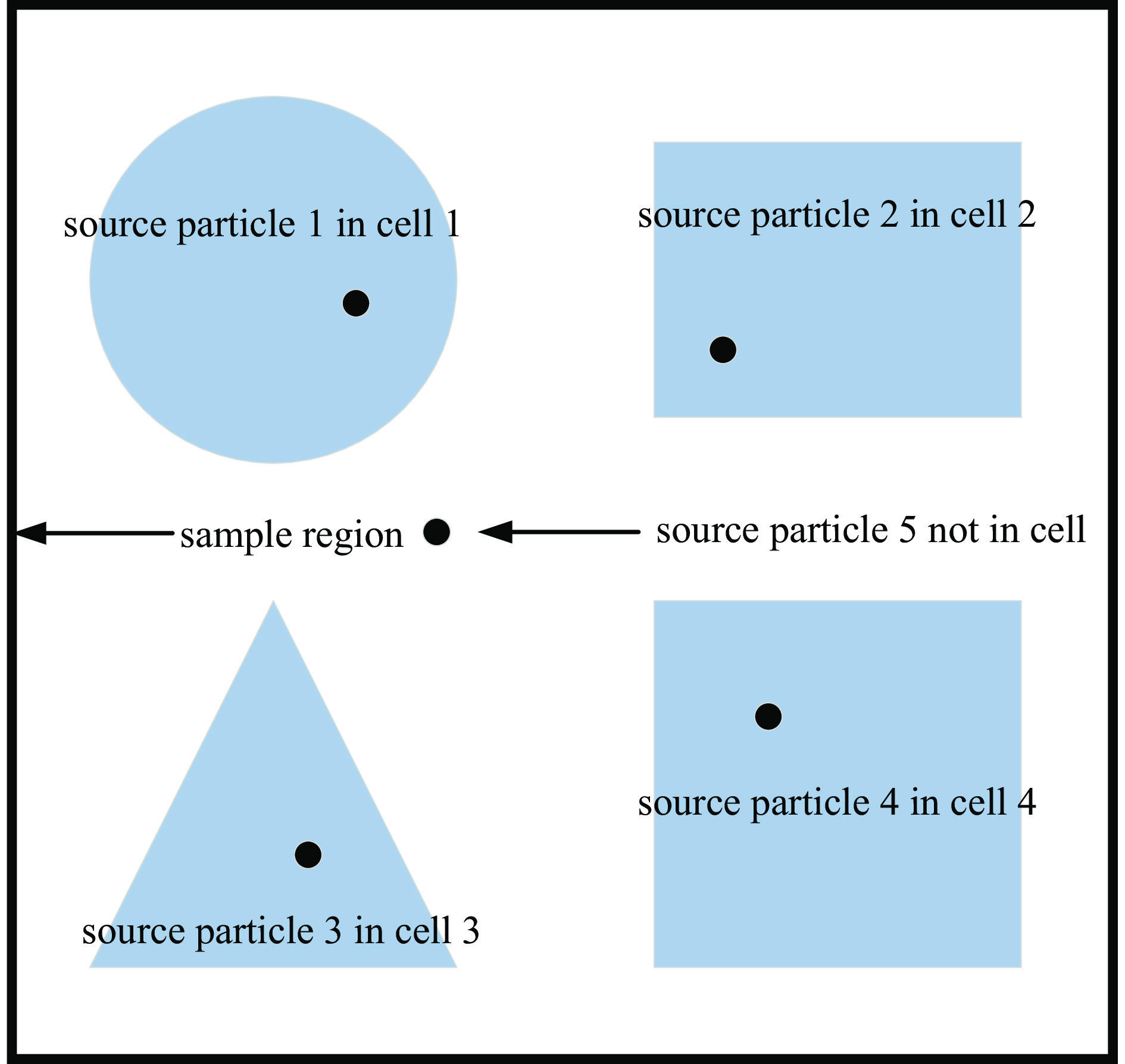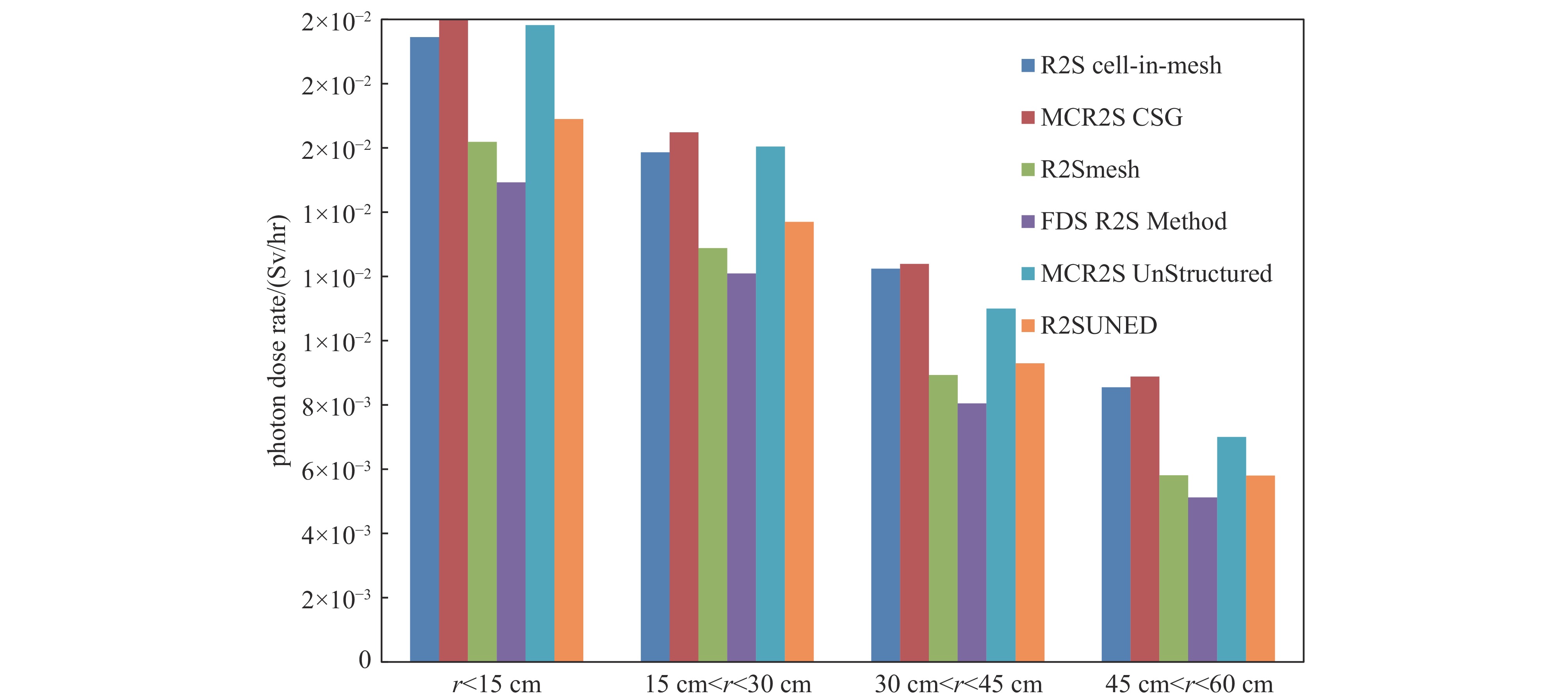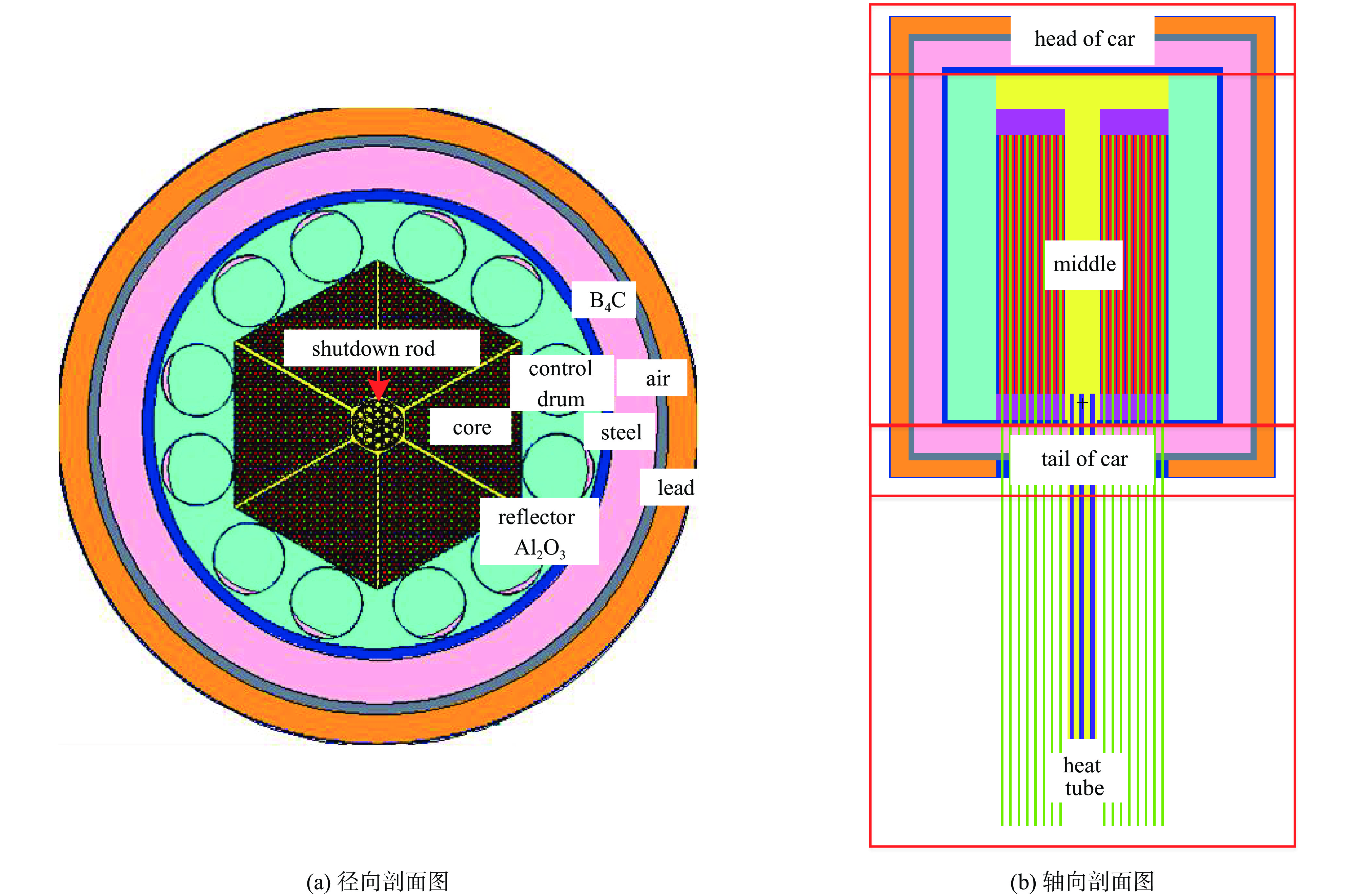Preliminary validation and application of shutdown dose rate calculation method based on cell-in-mesh
-
摘要: 停堆剂量率计算分析是核反应堆辐射安全的重要内容。为了分析车载微型移动核电源的停堆剂量率,研究了基于栅元嵌套网格的停堆剂量率计算方法。该方法在严格两步法的计算框架下,对活化光子源的抽样方法进行了改进。通过构建几何简单的包围盒,抽样得到源栅元内的粒子分布,从而提高了抽样效率和精度。在国际热核聚变实验堆(ITER)停堆剂量率基准题中进行了验证,该方法与参考解符合较好。基于该方法开展了兆瓦级车载微型移动核电源Megapower的停堆剂量率分析,计算结果表明热管贯穿端剂量率水平相对较高。该方法可用于反应堆停堆剂量率的计算分析,能够准确评估结构材料活化源及其产生的剂量率,对于反应堆屏蔽设计、维修计划的制定以及退役具有重要的参考意义。Abstract: Shutdown dose rate calculation and analysis is an important aspect of radiation safety for nuclear reactors. To analyze shutdown dose rate of vehicle-mounted micro-mobile nuclear power sources, this paper investigates a shutdown dose rate calculation method based on cell-in-mesh. Within the framework of the rigorous two-step method, improvements were made to the sampling method for activated photon sources. By constructing geometrically simple bounding boxes and sampling the particle distribution within the source cell, both sampling efficiency and accuracy were enhanced. This method was validated against the International Thermonuclear Experimental Reactor (ITER) shutdown dose rate benchmark problem, showing good agreement with reference solutions. Based on this method, a shutdown dose rate analysis was conducted for the megawatt-level vehicle-mounted micro-mobile nuclear power source Megapower, revealing that the dose rate level at the end of the heat pipe is relatively high. This method can be used for the calculation and analysis of reactor shutdown dose rates, accurately assessing structural material activation sources and their generated dose rates. It has significant reference value for reactor shielding design, maintenance planning, and decommissioning.
-
Key words:
- shutdown dose rate /
- rigorous two-step method /
- source particle sample /
- ITER benchmark /
- Megapower
-
表 1 ITER停堆剂量率基准题材料信息
Table 1. ITER shutdown dose rate benchmark material compositions
nuclide nuclide fraction nuclide nuclide fraction steel and water mixture steel steel and water mixture steel H 1.46E-01 − Mn 1.42E-02 1.82E-02 B 4.02E-05 5.14E-05 Fe 5.03E-01 6.44E-01 C 8.14E-04 1.04E-03 Co 3.68E-04 4.71E-04 N 2.17E-03 2.78E-03 Ni 9.06E-02 1.16E-01 O 7.29E-02 6.95E-05 Cu 2.05E-03 2.62E-03 Al 8.04E-04 1.03E-03 Zr 9.52E-06 1.22E-05 Si 7.73E-03 9.89E-03 Nb 4.67E-05 5.98E-05 P 3.50E-04 4.48E-04 Mo 1.13E-02 1.45E-02 S 1.02E-04 1.30E-04 Sn 7.31E-06 9.36E-06 K 5.55E-06 7.10E-06 Ta 2.40E-05 3.07E-05 Ti 1.36E-03 1.74E-03 W 2.36E-06 3.02E-06 V 3.41E-05 4.36E-05 Pb 1.68E-06 2.14E-06 Cr 1.46E-01 1.87E-01 Bi 1.66E-06 2.13E-06 表 2 ITER停堆剂量率基准题辐照历史
Table 2. ITER shutdown dose rate benchmark irradiation history
neutron source/(n/s) time repetition 1.0714E+17 2 y 1 8.25E+17 10 y 1 0 0.667 y 1.6607E+18 1.33 y 1 0 3920s 2.0E+19 400s 17 0 3920s 2.8E+19 400s 3 0 3920s 2.8E+19 400s 1 0 106s -
[1] Valenza D, Iida H, Plenteda R, et al. Proposal of shutdown dose estimation method by Monte Carlo code[J]. Fusion Engineering and Design, 2001, 55(4): 411-418. doi: 10.1016/S0920-3796(01)00188-0 [2] 陈义学, 吴宜灿, Fischer U. 核聚变装置停机剂量率分析计算的严格两步(R2S)法[J]. 核技术, 2003, 26(10):763-766Chen Yixue, Wu Yican, Fischer U. The rigorous 2-step calculation of shutdown dose rates for nuclear fusion devices[J]. Nuclear Techniques, 2003, 26(10): 763-766 [3] Kim J H, Woo M H, Shin C H, et al. A shutdown dose rates analysis of the Korean fusion demonstration reactor using MCNP5 mesh-based R2S approach[J]. Fusion Engineering and Design, 2021, 167: 112321. doi: 10.1016/j.fusengdes.2021.112321 [4] Sauvan P, Juárez R, Pedroche G, et al. D1SUNED system for the determination of decay photon related quantities[J]. Fusion Engineering and Design, 2020, 151: 111399. doi: 10.1016/j.fusengdes.2019.111399 [5] Serikov A G, Sheludjakov S V. Method for three-dimensional activation analysis of fusion reactor materials[J]. Plasma Devices and Operations, 2001, 9: 237-272. doi: 10.1080/10519990108229760 [6] 郑剑, 李斌, 邹俊, 等. 基于网格计数的停机剂量率计算方法研究[J]. 核科学与工程, 2016, 36(6):784-789Zheng Jian, Li Bin, Zou Jun, et al. Rigorous two-step shutdown dose rate calculation method based on mesh tally[J]. Nuclear Science and Engineering, 2016, 36(6): 784-789 [7] Sauvan P, Catalan J P, Ogando F, et al. Development of the R2SUNED code system for shutdown dose rate calculations[J]. IEEE Transactions on Nuclear Science, 2016, 63(1): 375-384. doi: 10.1109/TNS.2015.2507138 [8] Wilson S C, Mosher S W, Royston K E, et al. Validation of the MS-CADIS method for full-scale shutdown dose rate analysis[J]. Fusion Science and Technology, 2018, 74(4): 288-302. doi: 10.1080/15361055.2018.1483687 [9] Ibrahim A M, Peplow D E, Grove R E, et al. The multi-step CADIS method for shutdown dose rate calculations and uncertainty propagation[J]. Nuclear Technology, 2015, 192(3): 286-298. doi: 10.13182/NT15-1 [10] Jaboulay J C, Brun E, Hugot F X, et al. Rigorous-two-steps scheme of TRIPOLI-4 Monte Carlo code validation for shutdown dose rate calculation[J]. EPJ Web of Conferences, 2017, 153: 02008. doi: 10.1051/epjconf/201715302008 [11] Eade T, Colling B, Naish J, et al. Shutdown dose rate benchmarking using modern particle transport codes[J]. Nuclear Fusion, 2020, 60: 056024. doi: 10.1088/1741-4326/ab8181 [12] Eade T, Stonell D, Turner A. MCR2S Unstructured mesh capabilities for use in shutdown dose rate analysis[J]. Fusion Engineering and Design, 2015, 100: 321-333. doi: 10.1016/j.fusengdes.2015.06.189 [13] 李雷鸣, 江书益, 陈珍平, 等. 核反应堆结构材料网格精细活化分析研究[J]. 核技术, 2022, 45:080601Li Leiming, Jiang Shuyi, Chen Zhenping, et al. Mesh-based activation analysis for structural materials in nuclear reactor[J]. Nuclear Techniques, 2022, 45: 080601 [14] 张显, 刘仕倡, 卢棚, 等. 基于严格两步法的停堆剂量率计算程序的基准分析[J]. 辐射防护, 2023, 43(s1):20-24Zhang Xian, Liu Shichang, Lu Peng, et al. Benchmark analysis of shutdown dose rate calculation program based on R2S method[J]. Radiation Protection, 2023, 43(s1): 20-24 [15] Deng L, Ye T, Li G, et al. 3-D Monte Carlo neutron-photon transport code JMCT and its algorithms[C]//Proceedings of International Conference on Physics of Reactors. 2014. [16] Gauld I C. ORIGEN-S: SCALE system module to calculate fuel depletion, actinide transmutation, fission product buildup and decay, and associated radiation source terms[R]. ORNL/TM-2005/39, 2009. [17] American Nuclear Society. American national standard neutron and gamma-ray flux-to-dose-rate factors[R]. LaGrange Park, Illinois: American Nuclear Society, 1977. [18] Sterbentz J W, Werner J E, McKellar M G, et al. Special purpose nuclear reactor (5 MW) for reliable power at remote sites assessment report[R]. Idaho Falls: Idaho National Laboratory, 2017. -





 下载:
下载:






